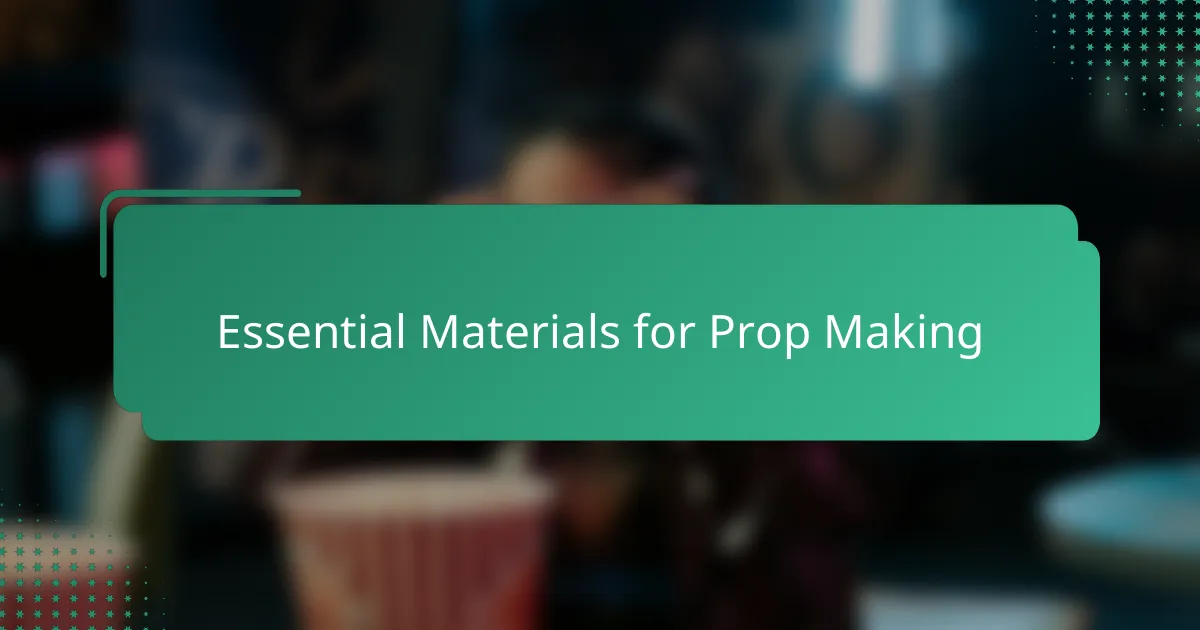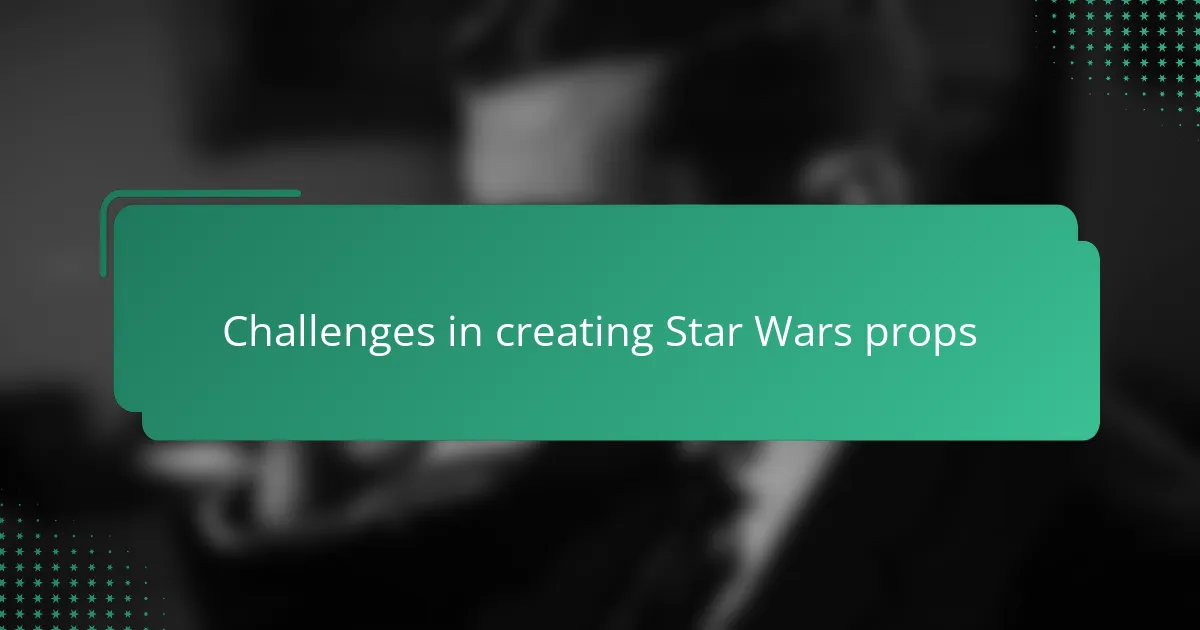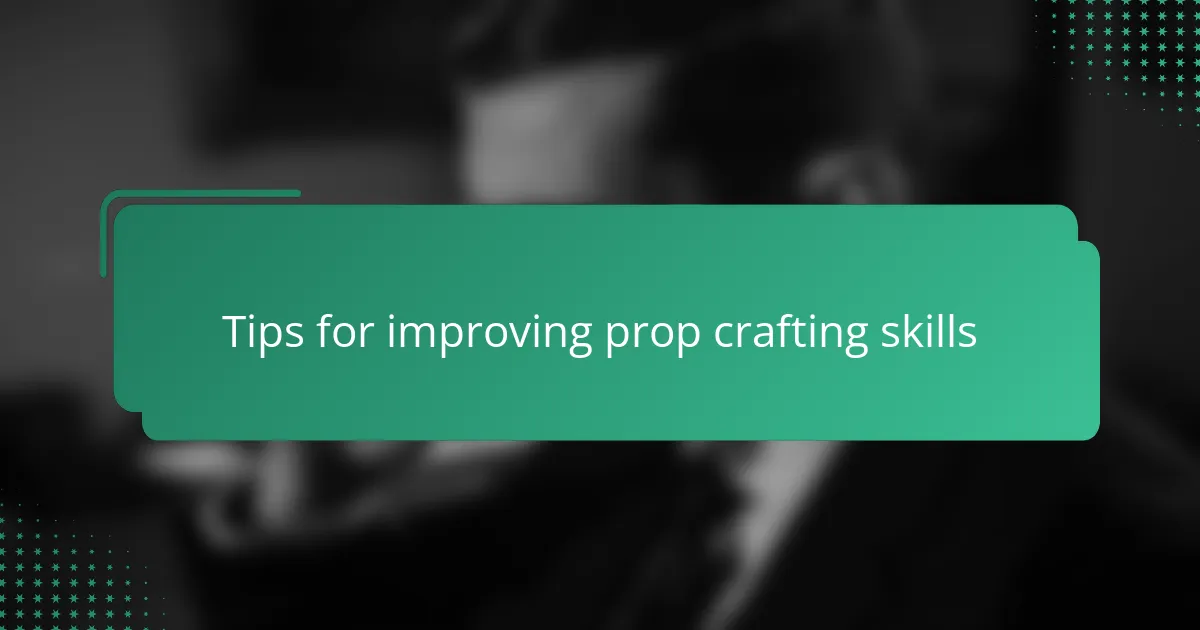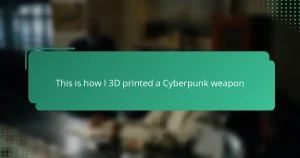Key takeaways
- Science fiction props tell stories and enhance the authenticity of a fictional universe through attention to detail and material choices.
- Choosing the right materials and tools is crucial for both the functionality and aesthetic appeal of props, impacting their overall quality and feel.
- A careful, step-by-step approach to planning, shaping, and detailing can significantly improve the crafting process and final results.
- Learning from mistakes, practicing specific techniques, and seeking feedback from others can help enhance prop making skills over time.

Understanding science fiction props
Science fiction props have always fascinated me because they blur the line between imagination and reality. When I first started creating them, I realized that understanding their purpose goes beyond just aesthetics; these props tell a story and bring a fictional universe to life. Have you ever wondered how a simple piece of plastic or metal can evoke such a strong sense of wonder and adventure?
From my experience, the magic lies in the details—the textures, colors, and even the weight of a prop contribute to its authenticity. I recall spending hours experimenting with different materials to capture that futuristic yet lived-in feel that Star Wars props are famous for. It’s amazing how tiny imperfections can make a prop feel genuinely part of its sci-fi world.
What makes science fiction props unique is their ability to challenge our perception of technology and possibility. I often find myself thinking about how these creations inspire curiosity about the future while grounding stories in something tangible. Isn’t it incredible that a well-crafted prop can spark our imagination and transport us to galaxies far, far away?

Essential materials for prop making
When I first dived into making Star Wars props, one of the biggest lessons was how crucial choosing the right materials really is. Foam, plastic sheets, and lightweight metals quickly became my go-to staples because they balance durability with ease of shaping. Have you ever struggled with something too heavy or brittle? I sure did, and it made me appreciate how vital material choice is for both the look and functionality of a prop.
What surprised me most was how common household items, like EVA foam or even PVC pipes, could be transformed into complex parts of a blaster or a helmet with some creativity. These materials not only save time but also allow for flexibility during the crafting process. I remember my first helmet turning out warped because I used the wrong kind of plastic—talk about a tough lesson learned!
Apart from structural materials, adhesives and paints became my secret weapons. Using the right glue ensures the pieces stay put, while weathering with acrylic paints added that authentic aged look I was chasing. It’s fascinating how a simple layer of paint can turn a plain prop into something that looks like it survived countless battles across the galaxy. Have you ever considered how much personality material finishes add to the final product?

Tools required for prop creation
When I first started building Star Wars props, I quickly found that having the right tools was just as important as picking the right materials. My basic toolkit included precision knives, rotary tools like a Dremel, and sanding blocks. These allowed me to carve, shape, and smooth intricate details that really brought the props to life. Have you ever tried cutting foam or plastic without a sharp blade? It’s frustrating and usually messy—I learned this the hard way.
Aside from cutting and shaping tools, I couldn’t imagine working without clamps and tweezers. These helped me hold tiny parts steady while gluing, which saved me from a lot of fumbling and misalignment. One time, I dropped a tiny blaster component and spent half an hour searching for it—those small tools definitely kept my sanity intact. It’s these small, precise actions that add up to making a prop feel authentic.
Painting and finishing require their own set of gadgets, too. Brushes in various sizes, airbrushes for smooth gradients, and masking tape for crisp lines became part of my routine. I remember being amazed by how an airbrush made weathering effects look less like a kid’s art project and more like something that actually belonged in the Star Wars universe. Have you thought about how much difference the right finishing tools make in selling the story behind the prop? For me, it was a game changer.

Step by step prop making process
The very first step in my prop-making journey always involves meticulous planning. I start by gathering detailed reference images to capture every angle and nuance of the Star Wars piece I want to recreate. Without these visuals, I quickly learned, it’s easy to miss key details that give the prop its character—have you ever tried building something only to realize halfway through that you missed a crucial part?
Next comes the rough shaping phase where I block out the general form using foam or plastic. This stage feels like sculpting clay; it’s hands-on and a bit forgiving, allowing me to adjust dimensions as I go. I recall one project where patience paid off—I spent hours sanding down an uneven curve until it matched the original perfectly, and that attention to shape made all the difference later on.
After shaping, the fun really begins with assembling and adding finer details. Gluing, layering, and carving smaller components bring the prop to life, but it can also test your patience—especially when tiny parts don’t want to fit as planned. What surprised me most is how weathering and paint layers transform these painstaking details into something that feels like it’s seen real battles and adventures, which is the ultimate reward in my process.

Challenges in creating Star Wars props
One of the biggest challenges I faced was balancing accuracy with practicality. Star Wars props often have intricate details that look incredible on screen but are tricky to replicate in real life. Have you ever tried to recreate something complicated but found it either too fragile or too heavy to handle? I certainly struggled with that, constantly tweaking my designs to stay faithful while keeping them wearable or displayable.
Another hurdle was sourcing the right materials that mimic the original textures and finishes. Early on, I remember staring at a piece that just didn’t have that authentic “used” look, despite hours of painting. It took me experimenting with different weathering techniques and layering paints to capture the worn metal or faded plastic that’s signature to Star Wars. It’s a painstaking process, but seeing that finish finally come together is incredibly rewarding.
Managing small parts also tested my patience. Tiny buttons, switches, or connectors might seem insignificant, but if one is slightly off or missing, the whole prop loses its magic. I can’t count how many times I had to undo and redo assembly steps because a piece didn’t quite fit or align. Have you ever lost a tiny component and felt like giving up? Those moments taught me the value of patience and precision in prop making.

My personal Star Wars prop projects
Working on my personal Star Wars prop projects has been a rollercoaster of creativity and frustration. I remember tackling a replica of a classic blaster, meticulously layering foam and plastic to get the right contours, only to realize halfway through that a key detail was missing. Have you ever hit that point where you just want to throw the whole thing out? Luckily, a bit of patience and some late-night research saved me — and that blaster eventually became one of my favorites.
One project that stands out was building a Mandalorian helmet from scratch. The challenge wasn’t just in shaping the form but in capturing that weathered, battle-worn look that feels so iconic. I spent evenings experimenting with paint washes and sanding techniques, watching the helmet slowly transform from a plain shell into a piece that seemed to carry stories of distant battles. There’s something deeply satisfying about breathing life into these props, don’t you think?
Sometimes, it’s the small victories that matter most. Like when a tricky assembly finally clicks together or when the final weathering nails the look so perfectly you swear it just came off a starship. These moments keep me hooked, reminding me why I dive back into another project despite the hurdles. Have you experienced that thrill of seeing your hard work look truly authentic? It’s what makes every scrape, each missed cut, and every late night completely worth it.

Tips for improving prop crafting skills
One tip that significantly boosted my prop crafting skills was embracing mistakes as part of the learning curve. Early on, I’d get frustrated when a piece didn’t fit or paint didn’t come out right. But over time, I realized those ‘failures’ pushed me to experiment with new techniques and materials. Have you ever felt stuck, only to discover that a misstep actually opened a door to a better approach?
Another habit I developed was dedicating time to practice specific skills like sanding or weathering separately from the main project. Breaking down the process helped me build confidence and precision in areas that once felt intimidating. For instance, practicing paint layering on scrap pieces made a huge difference when I moved on to actual props. Do you find that drilling down on one step at a time can turn daunting tasks into manageable challenges?
Finally, seeking feedback from fellow prop makers or online communities became invaluable. Sharing my work and hearing different perspectives not only inspired me but also highlighted details I might’ve overlooked. I remember posting a blaster build and receiving tips that completely transformed how I approached texturing. Isn’t it amazing how a fresh set of eyes can elevate your craft in ways you hadn’t imagined?


